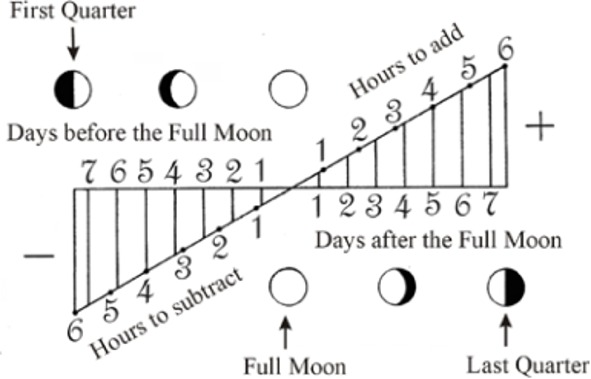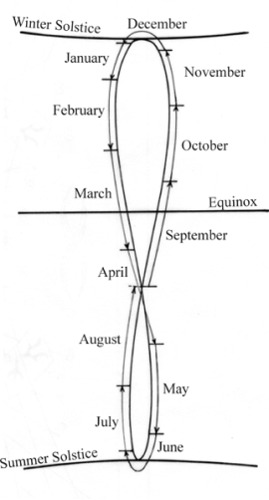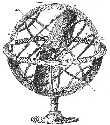|
Progettazione e Realizzazione Meridiane e Orologi Solari Bartolini Simone - Gnomonista in Firenze |
THE GNOMONIC FOUNTAIN
|
A Gnomonic System to observe
the Sun and the Moon
|
 |
|
The gnomonic fountain
|
 |
|
Photo 1 |
| The fountain, set up in the centre of the little square in front of the access staircase to the Temple, is built on two octagonal basements connected through eight trapezoidal faces and each face is inserted in a frame. Such faces, which have a tilt of 45 degree with respect to the horizontal, are oriented according to the four cardinal points (and the intermediate directions) (see Photo 2) | |||||||||||||||||||||||||||||||||||||||||||||||||||||||||||||||||
 |
|||||||||||||||||||||||||||||||||||||||||||||||||||||||||||||||||
|
Photo 2
|
|||||||||||||||||||||||||||||||||||||||||||||||||||||||||||||||||
|
NORTH -WEST face
|
|||||||||||||||||||||||||||||||||||||||||||||||||||||||||||||||||
 |
|||||||||||||||||||||||||||||||||||||||||||||||||||||||||||||||||
|
Photo 3
|
|||||||||||||||||||||||||||||||||||||||||||||||||||||||||||||||||
| The Earth' surface has been conventionally subdivided in 24 Hour Zone: each Hour Zone covers the surface space between two meridians 15° apart one from the other (that space corresponds to one hour of the rotating Earth). All the points of an Hour Zone have been conventionally given the same time, namely the time of its Central Meridian. | |||||||||||||||||||||||||||||||||||||||||||||||||||||||||||||||||
| The territory of some Countries intersects more than one Hour Zone; in particular, the China territory intersects 4 Hour Zones. In any case, the Chinese Government established that the whole China territory should be given the same time, namely the one relevant to the Hour Zone with its Central Meridian located 120° longitude East from Greenwich. | |||||||||||||||||||||||||||||||||||||||||||||||||||||||||||||||||
|
As a consequence, while the Sun crosses the Central
Meridian at midday of one day, in order to transit over the Hong Kong
Local Meridian the Earth still has to rotate through the longitude difference
between those two meridians (Central Meridian longitude = 120°;
Hong Kong longitude = 114°12'16"), i.e., 5° 47' 44",
corresponding, in terms of time, to 23m 11s.
|
|||||||||||||||||||||||||||||||||||||||||||||||||||||||||||||||||
| In order to evidence the above situation, the geographic map of China has been cut into this face, indicating the most important cities (see Photo 3). On the bottom side the longitudes have been reported, evidencing the Hong Kong longitude (114°12'16" East from Greenwich) and the Hour Zone Central Meridian (with longitude 120° East from Greenwich); on the upper side the corresponding values in hours and minutes of difference from the above Central Meridian. On the left and right sides the latitudes have been indicated. | |||||||||||||||||||||||||||||||||||||||||||||||||||||||||||||||||
|
This face is thus to evidence the different Solar
time of the several cities (unlike Civil hour). As a matter of fact,
the Solar time difference between the West and the East Ends of Chinese
territory is well 4 hours and 5 minutes. That means that when at the
West End is midday, at the East End it is 16h
05 m and in Hong Kong it is 14h
43m, while the Solar time, as referred to the
Central Meridian of the Hour Zone of longitude 120°, will be 15h
06m.
|
|||||||||||||||||||||||||||||||||||||||||||||||||||||||||||||||||
|
NORTH-EAST face
|
|||||||||||||||||||||||||||||||||||||||||||||||||||||||||||||||||
 |
|||||||||||||||||||||||||||||||||||||||||||||||||||||||||||||||||
|
Photo 4
|
|||||||||||||||||||||||||||||||||||||||||||||||||||||||||||||||||
| The discovery of clocks (necessarily running uniformly),
their diffusion and their higher and higher precision, led to adopt the
Mean Solar Time for civilian applications. In order to use the Sundials just like the common clocks, the Equation of Time has to be taken into account, i.e., the difference (E) between the Mean Solar Time (tm) and the True Solar Time (tv): |
|||||||||||||||||||||||||||||||||||||||||||||||||||||||||||||||||
|
(E) = (tm) - (tv)
|
|||||||||||||||||||||||||||||||||||||||||||||||||||||||||||||||||
| On this face the graphic of the Equation of Time has been reproduced indicating the values it assumes during the year (see Photo 4). | |||||||||||||||||||||||||||||||||||||||||||||||||||||||||||||||||
| On the top line of the face one can see the Chinese symbols, coming from the epoch Tang (618 - 907 d.C.), corresponding to the year's months. Those symbols have been made up in brass and inserted in the stone. | |||||||||||||||||||||||||||||||||||||||||||||||||||||||||||||||||
|
NORTH face
|
|||||||||||||||||||||||||||||||||||||||||||||||||||||||||||||||||
 |
|||||||||||||||||||||||||||||||||||||||||||||||||||||||||||||||||
|
Photo 5
|
|||||||||||||||||||||||||||||||||||||||||||||||||||||||||||||||||
| The North-West face concerns the Moon as a time-keeping (see Photo5). It may appear strange, but also the Moon shadows can be used to determine the Solar time and, consequently, the Civil time. | |||||||||||||||||||||||||||||||||||||||||||||||||||||||||||||||||
|
In the clear nights, when the Moon phase is not
too far from the Full Moon, at most 7 or 9 days before or after, we
can distinguish the shadows the Moon generates and thus we can read
the time using its position on the Celestial sphere.
|
|||||||||||||||||||||||||||||||||||||||||||||||||||||||||||||||||
| Since we are interested in the solar time, we have to refer the Moon position with respect to the Sun position and then to know the Moon motions. | |||||||||||||||||||||||||||||||||||||||||||||||||||||||||||||||||
| Every day the Moon is 48.8 minutes late with respect to the Sun and completes its revolution around the Earth during a 29.5 days period called lunation. The lunation, i.e. the different enlightening angle of the Moon by the Sun as seen from the Earth, determines the Moon's aspect and the sequence of its well known Moon phases. | |||||||||||||||||||||||||||||||||||||||||||||||||||||||||||||||||
| During the New Moon phase, we would read the actual time on the Sundial, while, during the Full Moon phase, we should apply a 12 hours correction (e.g., at 11 p.m. we would read 11 a.m. on the Sundial). | |||||||||||||||||||||||||||||||||||||||||||||||||||||||||||||||||
| The gnomonists, taking into account the low precision of Solar time as derived by Moon shadows, have rounded the lunation to30 days, giving rise to a 48 minutes (one thirtieth of 24 hours) daily delay of the Moon with respect to the Sun, instead of 48.8 minutes. Knowing he Moon "age", i.e. the amount of days from the New Moon phase, he Solar time can be computed as follows: | |||||||||||||||||||||||||||||||||||||||||||||||||||||||||||||||||
|
Solar time = time of Moon shadow on the Sundial
+ Moon age x 48 minutes
|
|||||||||||||||||||||||||||||||||||||||||||||||||||||||||||||||||
|
The Moon age value can be found consulting the
calendars and daily planning booklets which often report this kind of
information.
|
|||||||||||||||||||||||||||||||||||||||||||||||||||||||||||||||||
| In the box below a graphic relevant to the above situation has been reported. On the horizontal line the days before and after the Full Moon phase have been indicated, while on the inclined line the hours are indicated and the minutes can be estimated (Pic. 1). | |||||||||||||||||||||||||||||||||||||||||||||||||||||||||||||||||
|
CORRECTIONS AS FUNCTIONS OF THE
MOON AGE
|
|||||||||||||||||||||||||||||||||||||||||||||||||||||||||||||||||
 |
|||||||||||||||||||||||||||||||||||||||||||||||||||||||||||||||||
|
Pic. 1
|
|||||||||||||||||||||||||||||||||||||||||||||||||||||||||||||||||
|
EAST and WEST faces
|
|||||||||||||||||||||||||||||||||||||||||||||||||||||||||||||||||
 |
|||||||||||||||||||||||||||||||||||||||||||||||||||||||||||||||||
|
Photo 6
|
|||||||||||||||||||||||||||||||||||||||||||||||||||||||||||||||||
 |
|||||||||||||||||||||||||||||||||||||||||||||||||||||||||||||||||
|
Photo 7
|
|||||||||||||||||||||||||||||||||||||||||||||||||||||||||||||||||
| The two previous faces report the solar hours: the morning hours on the EAST face (Photo.6), the afternoon hours on the WEST face (Photo 7). The gnomon, which is perpendicular to the face, has a length which is 8/10 of the old Chinese measure belonging to the Tang epoch (618-907 A.D.), corresponding to 19.2 cm. | |||||||||||||||||||||||||||||||||||||||||||||||||||||||||||||||||
| The readings of the hours (with a precision of about
1-2 minutes) and of the present year's epoch, is performed observing the
center of the shadow produced by the little sphere on the top of the gnomon. On both faces, the diurnal lines are reported corresponding to the enter of the Sun into the zodiacal sign. The zodiacal signs, drawn according to the traditional western and Chinese styles, are reported only on the East face. |
|||||||||||||||||||||||||||||||||||||||||||||||||||||||||||||||||
| In the old time, about 2000 years ago, the ecliptic was subdivided into twelve parts, each with an amplitude of 30°, called zodiacal signs (from the zodiacal constellations). To each zodiacal sign an initial point, measured in ecliptic longitude, and the Sun passage epoch were assigned. | |||||||||||||||||||||||||||||||||||||||||||||||||||||||||||||||||
| With this representation it turned out that the day 21rst of March - Spring Equinox - was coincident with the beginning of Aries; 21rst of June - Summer Solstice - with the beginning of Cancer, and so on. In any case, it should be noted that, today, such a coincidence doesn't occur anymore due to the precession of Equinoxes, so that, at present, the Spring Equinox occurs within the sign of Pisces (the preceding one), in the sign of Taurus one can find the stars of Aries, and so on. | |||||||||||||||||||||||||||||||||||||||||||||||||||||||||||||||||
| In any case, conventionally, the Sundials make reference
to the Zodiac such it was 20 centuries ago. In table 1, the days and the declination values relevant to the Sun, when it enters the 12 constellations representing the twelve zodiacal signs, are reported. |
|||||||||||||||||||||||||||||||||||||||||||||||||||||||||||||||||
|
Table 1
|
|||||||||||||||||||||||||||||||||||||||||||||||||||||||||||||||||
|
|
|||||||||||||||||||||||||||||||||||||||||||||||||||||||||||||||||
|
|||||||||||||||||||||||||||||||||||||||||||||||||||||||||||||||||
| On the West face are also reported the diurnal lines relevant of the Chinese agricultural Calendar | |||||||||||||||||||||||||||||||||||||||||||||||||||||||||||||||||
| The Twenty-four Solar Terms | |||||||||||||||||||||||||||||||||||||||||||||||||||||||||||||||||
| The full text on the twenty-four solar terms can be found in Huainamzi: Astronomical Studies. As early as the Warring States (475-221 B.C.), solar terms were already seen in The Zhou Book of Jizhong: Notes on Seasonal Rules, albeit with slight difference in order from those of later times. Solar terms at the beginning of each month are called "Jieqi" and those in the middle of the month are called "zhongqi". | |||||||||||||||||||||||||||||||||||||||||||||||||||||||||||||||||
| From the Earth's perspective, the Sun moves through a year across the stars or celestial sphere along a path known as the ecliptic, which is measured in 360 degrees longitude. The 24 solar terms divide the ecliptic into 24 equal segments, with 15 degrees of the Sun's longitude between the terms. At "vernal equinox", the Sun's longitude is 0 degree; at "bright and clear", the Sun's longitude is 15 degrees; and so forth. | |||||||||||||||||||||||||||||||||||||||||||||||||||||||||||||||||
| At "vernal equinox" and "autumnal equinox", the periods of daylight and the night are equal in length. The period of daylight is the longest at "summer solstice" and the shortest at "winter solstice" (northern hemisphere). These were the earliest solar terms determined in ancient time. Then it came the four solar terms "spring commences", "summer commences", "autumn commences" and "winter commences". Other solar terms were named later according to the weather and agricultural activities prevalent at the respective times of the seasons. | |||||||||||||||||||||||||||||||||||||||||||||||||||||||||||||||||
| The "Spring commences" is the first term of the year. In the Han Dynasty, the first month of the year was called the Yin month and this has been in use ever since. Thus the "Spring commences jie" and the "Spring showers qi" fall on the Yin month. According to the twelve animals of the years, Yin is the Tiger. All the Jieqi, months and animals follow thus: the "Insects waken" and the "Vernal equinox" form the Mou month, and the animal is the Rabbit. The "Bright and clear" and the "Corn rain" fall on the Chen month, and the animal is the Dragon. The "Summer commences" and the "Corn forms" fall in the Si month, and the animal is the Snake. The "Corn on ear" and the "Summer solstice" fall on the Wu month, and the animal is the Horse. The "Moderate heat" and the "Great heat" fall on the Wei month, and the animal is the Goat. The "Autumn commences" and the "End of heat" fall on the Shen month, and the animal is the Monkey. The "White dew" and the "Autumnal equinox" fall on the You month, and the animal is the Rooster. The "Cold dew" and the "Frost" fall on the Xu month, and the animal is the Dog. The "Winter commences" and the "Light snow" fall on the Hai month, and the animal is the Pig. The "Heavy snow" and the "Winter solstice" fall on the Zi month, and the animal is the Rat. The "Moderate cold" and the "Severe cold" fall on the Chou month, and the animal is the Buffal. | |||||||||||||||||||||||||||||||||||||||||||||||||||||||||||||||||
|
SOUTH-EAST and SOUTH-WEST face
|
|||||||||||||||||||||||||||||||||||||||||||||||||||||||||||||||||
 |
|||||||||||||||||||||||||||||||||||||||||||||||||||||||||||||||||
|
Photo 8
|
|||||||||||||||||||||||||||||||||||||||||||||||||||||||||||||||||
 |
|||||||||||||||||||||||||||||||||||||||||||||||||||||||||||||||||
|
Photo 9
|
|||||||||||||||||||||||||||||||||||||||||||||||||||||||||||||||||
| These two faces show, for each day and for each point indicated by the gnomon shadow, the following data: | |||||||||||||||||||||||||||||||||||||||||||||||||||||||||||||||||
|
|||||||||||||||||||||||||||||||||||||||||||||||||||||||||||||||||
| The gnomon, which is perpendicular to the face, is 8/10 of the old Chinese measure of the Tang period (618-907 A.D.), corresponding to 19.2 cm. | |||||||||||||||||||||||||||||||||||||||||||||||||||||||||||||||||
|
SOUTH face
|
|||||||||||||||||||||||||||||||||||||||||||||||||||||||||||||||||
 |
|||||||||||||||||||||||||||||||||||||||||||||||||||||||||||||||||
|
Photo 10
|
|||||||||||||||||||||||||||||||||||||||||||||||||||||||||||||||||
| On this face two kind of lines are traced: those relevant to the Sun declination (comprised between +23° 26' e -23° 26') and those relevant to the Sun height above the horizon (values between 15° and 90°). Both kinds of line have a 5° spacing. The declination is the angle between the Celestial equator and the Sun, counted positively in the direction of the North Pole and negatively in the opposite direction (South Pole). | |||||||||||||||||||||||||||||||||||||||||||||||||||||||||||||||||
| The gnomon, unlike the others, carries a brass flower
with a hole in its center: the light spot through that hole is the measure
indicator for this face. The hole height from the face plane is 6/10 of
the old Chinese measure of the Tang period (618 - 907 A.D.), corresponding
to 14.4 cm. Moreover, a calendar has been carved on: for each month the relevant Chinese symbol (of the epoch Tang 618 - 907 d.C.) and a 10 day - interval subdivision are reported. |
|||||||||||||||||||||||||||||||||||||||||||||||||||||||||||||||||
| The day marks should be considered only approximate (± 1 day) because the Sun declination value in a specified day is different depending on the different year, due to three main reasons: | |||||||||||||||||||||||||||||||||||||||||||||||||||||||||||||||||
|
|||||||||||||||||||||||||||||||||||||||||||||||||||||||||||||||||
| The first reason is the most influencing: if, in a specified day, the gnomon projects the Sun spot on a certain mark, the year after, in the same day, it will be found on a slightly different position; the year still after the variation will be more sensible, and so on. The Sun spot will occupy the initial mark only during the fourth year. Only the Equinoxes and Solstices values remain almost the same. | |||||||||||||||||||||||||||||||||||||||||||||||||||||||||||||||||
| On the center (on the Midday hour line), the relevant lemniscate has been drawn. In the Pic. 2 a leminiscate and the relevant Calendar dates have been represented. Such curve makes possible to indicate the Mean Time directly on the Sundial without the need to apply the correction from the Time Equation (already seen before). | |||||||||||||||||||||||||||||||||||||||||||||||||||||||||||||||||
 |
|||||||||||||||||||||||||||||||||||||||||||||||||||||||||||||||||
|
Pic. 2
|
|||||||||||||||||||||||||||||||||||||||||||||||||||||||||||||||||
|
|
||||
|| |
























